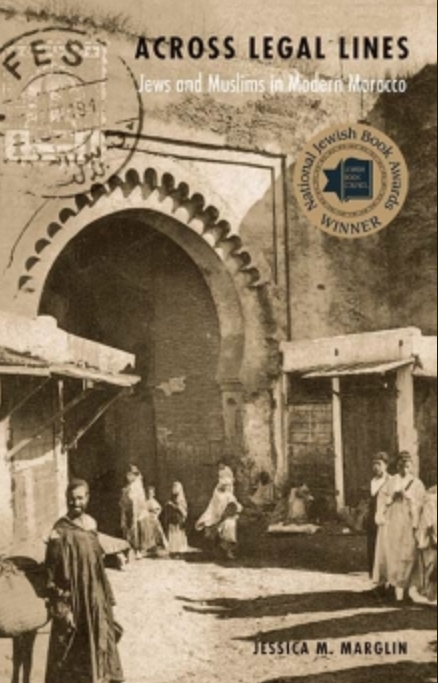
When reading this fascinating book written by Jessica Marglin, one cannot avoid recognizing the excellent guidance she received during her studies: Jessica Marglin benefited from the support of great scholars such as Susan Gilson Miller, Mark Cohen, Daniel Schroeter, Hossein Modarressi, Abraham Udovich, Lawrence Rosen and François Pouillon, just to mention a few of them. Thanks to that, and of course thanks to her great expertise, Marglin was able to analyse in a very original manner the personal archives of the Moroccan Jewish family of Shalom and Yaakov Assaraf (c. two thousand legal documents dating between 1850 and 1912), as well as a broad range of archival legal documents coming from archives of Muslim and non-Muslim Moroccan legal institutions. Marglin managed to demonstrate the changes occurred in the relations between Jews and Muslims in Morocco before and after the French colonization, an event that did not always result in an improvement of such relations.
The author begins by noting the paradox that the legal status of Jews in Morocco during the late nineteenth century was subordinate but at the same time a very mobile one, since – as dhimmis – they were afforded the right to appeal both to Jewish and Islamic courts. The possibility to choose between Jewish and Islamic law offered the Jews great mobility, and the advantages of choosing what seemed best for them according to the circumstances. Before colonization, Jews also acted as intermediaries with foreigners thanks to their status as political outsiders. Their work in consulates and in international trade, put them at least partly under the jurisdiction of consular courts – something that the French colonization made impossible.
Marglin highlights that when Jews were dhimmis, or in other words second-class citizens, paradoxically they had a greater possibility than the Muslims of moving across legal lines since – as said – they could make use of both Jewish and Islamic courts. The beginning of the French protectorate meant that this legal advantage was reduced and the legal boundaries between the two groups hardened, ending in the prohibition for Jews to appeal to Islamic courts. This meant that the French “added one more brick to the invisible wall that increasingly divided Jews from Muslims” (p. 9), changing their status for the worse. Ultimately, by reducing the jurisdiction of Jewish and shari’a courts, in particular when it came to family law, the French reforms helped in creating new racial and ethnic categories. As Marglin notes: “Law acted as a vector of integration into Moroccan society in the pre-colonial period […] yet law also contributed to driving Jews and Muslims apart under colonial rule and to setting the stage for Jews’ exodus from Morocco” (p. 20). Differences between Jews and Muslims, that existed already before colonization, were then transformed and strengthened by colonial legal reforms that introduced more rigid boundaries between the two groups.
While confirming on the one hand what other historians already showed, namely that the mellah – the Jewish quarter – was primarily, but not exclusively, a Jewish space, on the other Marglin demonstrated that also Jewish legal institutions were not exclusively oriented towards Jews: Muslims too made use of them. Jews used shari’a courts because they participated in the economic life of Morocco and conducted business with Muslims. Surely, appealing to Islamic courts facilitated the commercial relations with Muslims. Anyhow, as the author explains well, the use of these courts may be seen also as an indicator of the trust that existed between the two groups not only when it came to economic integration but also, although perhaps to a lesser degree, the social integration. The use of Jewish courts by Muslims is not a very common, or at least very documented, event: it is, in fact, something that until now almost entirely escaped the attention of scholars. This makes Marglin’s research even more valuable. Of great interest is also Marglin’s discussion of the use made by Jewish women of Islamic courts for matters concerning family law: for example, the possibility to seek for a divorce, considering that the Islamic law permits women to initiate a divorce while Jewish law recognizes divorce only if initiated by the husband. This was sometimes a way for Moroccan Jewish women to expedite the process leading them to obtain a get from their husbands.
The French colonization created a clear legal separation between foreigners and indigènes, Jews and Muslims; abolished the System of Capitulations and restricted the competence of shari’a and Jewish courts. It also obliged the Jews to use only Hebrew in the Batey din and not – as done until then – a combination of different languages including Judeo-Arabic or Judeo-Spanish. On the whole, the French were concerned with maintaining a specific administrative and judicial system for Jews only, with the consequence of creating a deeper division between them and the Muslims. The new legal framework introduced by the French limited the power of shari’a courts and excluded commercial matters from it, forcing the Jews to make use of the Makhzan courts.
To conclude, the book offers an original reading of the impact of French colonization on the relations between Jews and Muslims and on the changes it brought about. Thanks to Marglin’s reading of documents coming from both Islamic and Jewish milieus, the research allows us to grasp the articulations of a very complex society. This is done in a very fine, synchronic way and not – as one sees too often – with an eye to contemporary events. It is to be hoped that Across Legal Lines will stimulate further research on these topics, based on documents produced by both Jewish and Muslim institutions and adopting a critical gaze capable of crossing ethnic and religious borders.
Emanuela Trevisan Semi, Ca’ Foscari University of Venice
Jessica M. Marglin, Across Legal Lines: Jews and Muslims in Modern Morocco, (Yale: Yale University Press, 2016), pp. 336.
DOI : 10.48248/issn.2037-741X/675